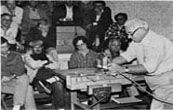|
Ask the
Experts
Question:
What's the difference
between Clifton and Lie-Nielsen bench planes?
Answer:
As stated in
our catalog, Clifton and Lie-Nielsen bench planes are built with
Stanley's Bed Rock frog design (see catalog for a detailed
description of the Bed Rock frog). Although both companies produce a
steel plane superior to anything currently available, there are some
differences noting other than price.
Looks:
Aesthetically, Lie-Nielsens have a
flat black japanned finish, Stanley-style cherry totes/knobs and a
squared side rail much like Stanley's Post-1911 Bed Rocks. The
Cliftons are japanned in glossy British racing green with Miller's
Falls-style bubinga totes/knobs and rounded Bailey side rails
similar to Stanley's earlier Bed
Rocks.
Function:
Mechanically, both planes function
basically the same. Frog and throat adjustments can be made without
removing the blade assembly. Blade advancement and lateral movement
work equally fine in familiar ways.
Materials:
The
major differences are in body materials and blade assembly.
Lie-Nielsen makes its bodies in ductile iron, which is quite shock
resistant. Clifton manufactures their plane bodies from gray iron,
same as Stanley and Record. Gray iron is not as shock resistant as
ductile iron. The moral of this story is not to drop your
heirloom-quality plane on a concrete floor, or your blade for that
matter.
Blades and Chip Breakers:
Clifton
hand-hammers their blades and Lie-Nielsen drop-forges their blades.
Both blades are of excellent quality, approximately 1/8" thick to
reduce chatter. Clifton blades seem to hold an edge slightly longer.
Lie-Nielsen planes come with the usual chip breaker much like
Stanley and Record planes. The two-piece chip breaker from Clifton
adds mass to the blade assembly and holds the iron flat on the frog
with pressure on the blade when the lever cap locks
down.
The Bottom Line:
If you're dissatisfied with
the quality of standard fare steel planes, then either a Lie-Nielsen
or a Clifton will surely appeal to you. After some minor tuning,
blade honing and throat adjusting, (see Garrett Hack's
The Hand Plane
Book
), these planes will give world-class
performance. At this point consider price, form and visual appeal.
After all, you'll have to look at it for a long time, and a
beautiful plane is a source of joy forever. Then meditate on the
differences above and decide. I'm sure you'll be pleased with these
fine tools.
|



